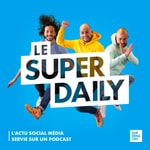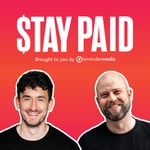The Substack Podcast – Details, episodes & analysis
Podcast details
Technical and general information from the podcast's RSS feed.

The Substack Podcast
The Substack team
Frequency: 1 episode/44d. Total Eps: 56

on.substack.com
Recent rankings
Latest chart positions across Apple Podcasts and Spotify rankings.
Apple Podcasts
🇨🇦 Canada - books
03/08/2025#74🇨🇦 Canada - books
02/08/2025#65🇨🇦 Canada - books
01/08/2025#82🇨🇦 Canada - books
29/07/2025#75🇨🇦 Canada - books
28/07/2025#45🇨🇦 Canada - books
27/07/2025#41🇺🇸 USA - books
24/07/2025#94🇺🇸 USA - books
23/07/2025#94🇺🇸 USA - books
21/07/2025#97🇺🇸 USA - books
20/07/2025#89
Spotify
No recent rankings available
Shared links between episodes and podcasts
Links found in episode descriptions and other podcasts that share them.
See all- https://unsplash.com/
316 shares
- https://maps.org/
121 shares
- https://twitter.com/APompliano
72 shares
- https://twitter.com/nikillinit
20 shares
- https://twitter.com/JuddLegum
8 shares
- https://www.patreon.com/CANADALAND
81 shares
RSS feed quality and score
Technical evaluation of the podcast's RSS feed quality and structure.
See allScore global : 43%
Publication history
Monthly episode publishing history over the past years.
‘Get a dose of sanity’: How Dan Harris found success with live videos
vendredi 17 janvier 2025 • Duration 03:51
Dan Harris is a bestselling author, the host of the 10% Happier podcast, and a former ABC news anchor. He went live with Substack CEO Chris Best yesterday to share the creative ways he’s been using live video in the Substack app, and offered recommendations for others hoping to take advantage of the feature. Here, we’re sharing a few highlights from their conversation.
Learn more about going live on Substack:
On getting creative with live videos
Chris Best: This feature that we’re using right now, Substack Live, it’s a new thing for us. It’s something that we’ve developed relatively recently. And you have been one of the people who is using it not only very successfully but, in my view, very creatively. And I’d love to hear from you, how are you thinking about it? And what is the live piece of what you’ve been doing on Substack?
Dan Harris: Essentially, it’s 10 minutes of guided meditation, and then I take questions. And so what we’ve been doing recently, for example, is a series of live guided meditations starting on Sunday, running through Wednesday, to help people deal with the tumult around Trump’s inauguration. No matter where you stand, people have strong feelings. And so we’re creating a place where people can come, get a dose of sanity in the form of a meditation from me, and then ask questions.
On the benefits for paid subscribers versus free
Dan Harris: One of the benefits that we’ll be providing to our paid subscribers is we’ll create a chat very soon where only paid subscribers can submit their questions in advance, and those will get preferential treatment. We do a mix of live events for paid subscribers and for everybody. So [these] inauguration [meditations] will be for everybody.
We [also] did a bunch of stuff around the election. We did a series called Election Sanity that was free for everybody. And I also do a monthly paid-subscriber-only AMA, and I’m probably going to up the cadence on that to much, much more [frequent] because the response has been so good.
On the value of posting a live video after it ends
Dan Harris: What we’re seeing is that we get a certain amount of people who tune in live, but we get sometimes 10, 20, 30 times that [number] watching it asynchronously later.
On when to promote a live video
Chris Best: So do you tell people, like, “Hey, this is coming up today. Tune in at this time.” And just give them a little taste of it? How do you promote on [the different] platforms?
Dan Harris: It really depends on the platform. On Substack, we’re trying to give plenty of notice. So today, we sent out an email to all of our subscribers saying that starting on Sunday, we will be doing Sunday, Monday, Tuesday, Wednesday—four days of programming around the inauguration. So we gave some heads-up and we gave times, so people can put it in their calendars.
On Instagram and on Notes, it’s more like, “Hey, this is happening right now. You should come check it out.”
On using collaborative live video to grow
Dan Harris: I have found that working with fellow Substackers has been really helpful. I mentioned I’m doing a series of lives around the inauguration—Sharon McMahon and Van Jones will be participating in those lives with me. And I’ve done joint posts with Susan Cain. And I just got an email this morning from Elizabeth Gilbert, and we’ll do a thing.
And so I actually think if you’re looking to grow, partnering with these other amazing people on the platform is a great opportunity.
This conversation has been edited for length and clarity.
This is a public episode. If you would like to discuss this with other subscribers or get access to bonus episodes, visit on.substack.com
Dear writer: Advice on creating a sacred writing space
mercredi 4 octobre 2023 • Duration 04:28
We asked , who writes on Substack, for advice on making her new Substack sustainable, slowly and steadily cultivating a sacred space for exploring writing and ideas, and building her community.
Jamie is an author, designer, digital course creator, and creative consultant living in Los Angeles. Her debut novel, Main Character Energy, was published in September 2023 by the HarperCollins imprint Park Row Books. Her previous nonfiction memoir, Radically Content, is currently being developed into a feature film, and her digital course, Live with Intention, has helped over 1,300 people live more intentional lives. Her work has appeared in the HuffPost, Teen Vogue, and POPSUGAR and been shared by millions online. Read on for Jamie’s advice, or listen to her read it aloud in this episode.
This is the latest post in a recurring series of longform writer advice. To see more advice from Substack writers, take a look at previous posts here.
This is a public episode. If you would like to discuss this with other subscribers or get access to bonus episodes, visit on.substack.com
Dear Writer: Advice on bringing your unique skills together
jeudi 9 juin 2022 • Duration 05:32
We asked Robert Reich to share his advice on learning to use his writing and drawing skills to illustrate his Substack. Read on for Robert’s advice, or listen to him read it aloud above.
This is the fifth in a recurring series of longform writer advice, following Alicia Kennedy’s advise on learning to listen, Embedded’s Kate Lindsay’s advice on creating trust with your readers, Lance’s Anna Codrea-Rado’s advice on learning to celebrate just how far you’ve come, and Mason Currey’s advice on creative growth.
Could you use some advice or inspiration from a fellow writer about creativity, motivation, and the writing life? Submit your question for consideration for a future advice column by leaving it in the comments below.
This is a public episode. If you would like to discuss this with other subscribers or get access to bonus episodes, visit on.substack.com
Dear Writer: Advice on writing through isolation
lundi 6 juin 2022 • Duration 06:38
We asked Helena Fitzgerald to share her advice on navigating isolation as a writer. Helena writes Griefbacon—a newsletter on the weirdness of relationships for “the last people at the party after everyone else has gone home.” Listen on for her experience of solitude in writing, or listen to her read it aloud above.
Dear writer, how does isolation play into your writing experience? When do you crave it, and at what point do you seek support, collaboration, or edits? How do you come up for air when the loneliness of writing becomes too much?
*
This is the fifth in a recurring series of longform writer advice, following Alicia Kennedy’s advice on learning to listen, Embedded’s Kate Lindsay’s advice on creating trust with your readers, Lance’s Anna Codrea-Rado’s advice on learning to celebrate just how far you’ve come, and Mason Currey’s advice on creative growth.
Could you use some advice or inspiration from a fellow writer about creativity, motivation, and the writing life? Submit your question for consideration for a future advice column by leaving it in the comments on Substack.
This is a public episode. If you would like to discuss this with other subscribers or get access to bonus episodes, visit on.substack.com
Coming Soon: A special opportunity for sound-centric publications
jeudi 19 mai 2022 • Duration 01:18
Are you a podcaster, audio creator, or author of a sound-focused publication? Next month, Substack will open applications for our next intensive: the Summer of Sound.
In this month-long immersive workshop, we will invite a select group of writers and audio creators to deepen their focus, build a strategy, test techniques, and grow their publications into sustainable projects.
Applications will open on June 9, 2022, and close on June 21, 2022. To be eligible for this opportunity, applicants need to have an existing publication on Substack with at least 5 posts. If you want to kickstart, revive, or grow a podcast, audio show, or sound project on Substack, now is the time!
To learn more about podcasting and audio tools, check out our resources and our support articles.
We are looking for writers and creators with a substantial audience, growth potential, and a strong desire to grow an independent media business on Substack. Once selected, participants will dedicate a considerable portion of time in late July and August to developing their publication strategies, experimenting with our features, and learning from experts.
We’ll share more information as we prepare to launch the application in June.
Read more: How to move your podcast over to Substack and Podcasting questions answered
This is a public episode. If you would like to discuss this with other subscribers or get access to bonus episodes, visit on.substack.com
Learnings from one year of Writer Office Hours
jeudi 12 mai 2022 • Duration 03:45
One year ago this week, writers and the Substack team started gathering in weekly Office Hours discussion threads together for the first time. In 38 threads with tens of thousands of comments, writers shared bold ambitions for publishing on Substack, swapped sharp insights on growing an engaged email list, and celebrated milestones like going paid.
A year in and the discussion threads continue, with writers learning and navigating a new chapter for online publishing. Together through Office Hours, Substack writers have authored advice for the future.
In 1997, Chicago Tribune columnist Mary Schmich wrote an essay as a hypothetical commencement speech entitled “Advice, like youth, probably just wasted on the young.” Going viral, the essay was adapted and shared as a spoken word song by Baz Luhrmann. “Everybody's Free (To Wear Sunscreen)” was an instant hit.
Today, we bring you Substack’s remix from lessons and advice writers have shared over the past year in Office Hours read by Jackie Dana, one of the generous Office Hours stewards.
Everybody’s free (to connect with each other)
Writers and readers of the class of '22:Connect with each other.
If we could offer you only one tip for the future, connecting with each other would be it. The long term effects of engaging have been proved by data scientists whereas the rest of our advice has no basis more reliable than our own meandering experience. On behalf of the writers of Substack, we will dispense this advice now:
Don't wait for your writing to be perfect, or the time to be just right. Neither will happen. Your publication will likely be quiet for a while. Keep going anyway. Building something good takes time. The only real short cut is luck, and that’s no real strategy.
Don't try to do this alone. The actual writing part usually has to be done alone, with distractions turned off and a faintly unhealthy supply of coffee to hand. There's usually no getting around that. But the part where you're coming up with ideas, or trying to think bigger and bolstering your confidence and hopes...don't try to do that just by sitting by yourself. If you need the door closed when you're writing, try flinging it open when you're not.
Learn wildly. Connect madly. Allow yourself to be corrected. Being gracious in the face of criticism is a good way to take the venom out of it. And make lots of good friends who are doing something like what you're doing. As writers, we are all in this together so we need to do our best to help each other grow and succeed.
Slow and steady is entirely normal growth. Some people come to Substack with an enormous platform already. Some people grow very quickly for a variety of reasons (very few of which are actually controllable). The vast majority of us just plug along, trying different things, without ever having insane overnight success. Doesn't mean you can't be successful, it just means "slow and steady" is entirely normal growth, and success is subjective and depends on your own personal newsletter and goals.
Extra slow days shall pass. It's hard but just keep writing good copy during the plateaus. They too will end.
Dive deep into your niche. The average person on the street may not understand the appeal of your Substack, but you'll gain loyal subscribers and face less competition than if you go mainstream.
Don't feed trolls. Don't allow them to ruin your day. Just block them and move on.
Celebrate at milsteones. Exclaim: Bravo!!!!! This is awesome! Way to go! That's huge - congrats!!!
Remember: engagement is not just likes and comments, but also conversations between you and your reader in their inbox. Ask questions. Propose ideas. Agree. Disagree. Agree to disagree.
Be careful with the advice you take to heart and put in practice. You might find yourself saying, “I actually didn't follow that advice, and I'm happy I didn't.”
But trust us on connecting with others.
We also want to take a moment to pause and say thank you to the writers who have made helping other writers at Office Hours this year a central rhythm in their week by attending the majority of sessions, and generously answering other writers questions. We hope you'll join us in giving the following writers a virtual applause.
Jackie Dana, Cole Noble, Sarah Miller, Alison Acheson, Elizabeth Held, Michael Fritzell, Geoffrey Golden, Mike Sowden, E. Jean Carroll, Melanie Newfield, YouTopian Journey, Paul Macko, Joan Demartin, Chevanne, Lloyd Lemons, Karen Hoffman, moviewise, Петър, Emily Miller, Heather Johnston Brebaugh, Linda Tapp, Rishikesh Sreehari, and Asha Sanaker.
Join us for Office Hours today
Each week on Thursdays, we gather the writer community and members of our Community, Product, and Writer Development teams together in a written discussion thread like this one to answer writer questions for an hour.
Whether you are returning to the thread to celebrate one year of Office Hours or joining for the first time, we hope to see you today. Together we will answer your questions on publishing, growing, or going paid on Substack.
Do you have a favorite memory from Office Hours?
A sharp insight that you learned that you’ve taken with you? Someone you met in the discussion threads that you’ve stayed in touch with? We’d love to hear about it in celebration of one years of hosting Office Hours.
This is a public episode. If you would like to discuss this with other subscribers or get access to bonus episodes, visit on.substack.com
Dear writer: Advice on preserving your energy
lundi 25 avril 2022 • Duration
We asked writer, author, and podcaster Emma Gannon to share her advice on maintaining your energy to keep writing. Emma has had an extraordinary few years, publishing four more books, continuing her acclaimed podcast Ctrl Alt Delete, and adding ever more value to her ever-growing community. Emma recently moved her newsletter, The Hyphen by Emma Gannon, to Substack, where she also shares discussion threads, book recommendations, and Q&As. Read on for her advice, or listen to her read it aloud.
This is the fifth in a recurring series of longform writer advice, following podcaster Alicia Kennedy’s advice on learning to listen, Embedded’s Kate Lindsay’s advice on creating trust with your readers, Lance’s Anna Codrea-Rado’s advice on learning to celebrate just how far you’ve come, and Mason Currey’s advice on creative growth.
Could you use some advice or inspiration from a fellow writer about creativity, motivation, and the writing life? Submit your question for consideration for a future advice column by leaving it in the comments on Substack.
This is a public episode. If you would like to discuss this with other subscribers or get access to bonus episodes, visit on.substack.com
Dear Writer: Advice on conducting a great interview
lundi 11 avril 2022 • Duration
We asked Alicia Kennedy to share her advice on interviewing. She calls From the Desk of Alicia Kennedy Podcast, her weekly podcast that’s part of her food newsletter, “a curated conversation series.” She recently wrote about her belief in unscripted, unedited interviews here. Read on for her advice, or listen to her read it aloud above.
Dear writer and podcaster, what’s the secret to a good interview?
My podcast always begins with the same question: “Can you tell me about where you grew up and what you ate?” This establishes the conversation in some straightforward biography, while also grounding it in the flavors and food philosophies that have shaped the guest’s life. From there, the audience and I will get to go deeper, but the guest sets the terms of the conversation by choosing what and how much to share. Do they become wistful and nostalgic, or do these memories seem painful? Are they tinged by grief and loss, or by joy and whimsy? The question sets the tone and tenor of the rest of the conversation.
To me, a good interview is governed by the same thing as good nonfiction writing: curiosity. I’ve made mistakes before by doing interviews with people whose work I, frankly, was not curious about, and that means I’m just going through the motions. But what makes an interview good for the audience—whether a listener or reader—is that the people having the conversation are actively engaged with each other, and ideally with each other’s work. As an interviewer, I want the people listening to feel like they’re overhearing a natural conversation, something that would happen spontaneously after the plates are cleared away from the dinner table and all that’s left is some wine and cake.
There also needs to be a spirit of generosity on the part of the person being interviewed. When people come on who’ve never bothered to listen to a past episode and don’t respond generously to good-faith questions, it can feel like pulling teeth. I’ve learned for myself, whether I’m the host or the guest, that I shouldn’t show up unless I can get locked into having a generous conversation. This means being curious and being engaged, of course, but also believing that every question is a good question, a worthwhile question, and if I think perhaps it hasn’t been phrased well, that I can reframe it in my response.
I want the people listening to feel like they’re overhearing a natural conversation, something that would happen spontaneously after the plates are cleared away from the dinner table and all that’s left is some wine and cake.
In order to facilitate better conversations, I send my guests the questions a week ahead of time. This provides not too much time to overprepare and thus kill spontaneity, but it does allow them to get a sense of the trajectory of the conversation and tell me whether they’d prefer to go in another direction. I want guests to be comfortable and know that it will be a safe space for anything they wish to talk about, and I like to establish their boundaries ahead of time.
I try to ask big, open questions, too, so that the guest feels free to take their response in any direction. Specific questions, I’ve found, lend themselves too easily to simple answers. The worst feeling is to receive a “yes” or “no” in response. Though sometimes one can want to flex just how deep they’ve researched in their questions, I find it better to be looser and to let the guest guide the conversation a bit, because their spontaneity will also be more compelling to the listener.
In writing these bigger, more open questions, I dive into all the person’s work and also try to listen to or read past interviews. I want to honor the subjects that drive the guest’s life while also bringing something different to it, something less anticipated. My questions that I ask to everyone are very important for this reason, such as in how I begin, but also in how I finish, which is with the same two questions. Each guest responds to the same questions in new ways.
I want to honor the subjects that drive the guest’s life while also bringing something different to it, something less anticipated.
I used to ask just, “For you, is cooking a political act?” but I change it up based on whether the guest has told me they like to cook or not. If they don’t, I ask about writing or bartending or whatever it is they put all their soul into. I’ve begun to add the question “How do you define abundance?” because the concept of “abundance” keeps working its way into my own writing—how we define it, yes, as well as how to cultivate it and how to reframe it in a world that tries to tell us abundance looks one way, means one thing.
My podcast is, in this way, an extension of my writing, a way to engage with its themes with folks who’ve done different kinds of work in food and culture, who can bring new perspectives to themes I work with consistently. We all eat and engage with food differently, and I want to honor that diversity through generous, curious conversation.
Sincerely,
Alicia
This is the fourth in a recurring series of longform writer advice, following Embedded’s Kate Lindsay’s advice on creating trust with your readers, Lance’s Anna Codrea-Rado’s advice on learning to celebrate just how far you’ve come, and Mason Currey’s advice on creative growth.
Could you use some advice or inspiration from a fellow writer about creativity, motivation, and the writing life? Submit your question for consideration for a future advice column by leaving it in the comments below.
This is a public episode. If you would like to discuss this with other subscribers or get access to bonus episodes, visit on.substack.com
Podcasting, but better
mardi 5 avril 2022 • Duration 03:22
The best thing about being a podcaster is the joy of a really good conversation. It feels like that moment at a cocktail party when you find yourself in a corner by the cheese table, chatting with the most interesting person there. And then it gets even better: you get to share that conversation with your listeners, who come along for the ride and experience it with you.
But then you click publish, and suddenly the experience of podcasting becomes very one way. Sure, you get some download numbers; maybe you get some Twitter noise around an episode; maybe you get an Apple review. But for the most part, it feels like you push this rich conversation out… into a strange, empty ether.
That’s what makes podcasting on Substack so different. Suddenly, the podcast can keep the conversation going. With most other podcast platforms, the best you can hope for is to keep a listener’s attention for a fleeting moment. But here, you know who your listeners are. These listeners aren’t just download numbers: you speak to them in a direct relationship, through their email. You bring them into your world, where they read around a bit, maybe comment, maybe even put their email address down right away.
In this new relationship, your listeners know you more intimately, too. You talk to them not just through the podcast but through writing; through more video, and audio, and images; through show notes that might be more album notes or essays than blurbs. In this podcasting universe, podcasters are more than podcasters, and listeners become more than listeners: they become a community. They can listen, and read, comment, and discuss—with you and with each other, online, in email, and in the app—and respond right back.
Writers on Substack have done so much more than just create newsletters. They went independent and became media outlets in their own rights. They created new communities. They changed the entire business model of writing, making it unnecessary to pander to algorithms or advertising.
That’s what’s coming now for podcasting. The same way we made it simple to start a paid newsletter, we’re making it just as easy to produce a paid, subscription-based podcast on Substack. You can push every new episode to your readers and subscribers, on the Substack app and other podcast players, as easily as publishing a post in your newsletter. Owning your own audience also means something very different here than anywhere else: we make it easier for you to get and keep new listeners, and you’re never locked in with constraints around keeping those emails or payment systems.
Just like Substack gave writers the freedom to be writers again, the Substack model of podcasting will bring the format to its pinnacle. Before, podcasting was a monologue into the void. Now, it’s a rich conversation listeners are invited into, a deeper connection with your own community. The world of ideas doesn’t need to be boiled down to one format—or one direction.
So take a peek behind the Hollywood curtain with The Ankler; explore science and culture with The Origins; pick apart the news with The Fifth Column; level up your finance game with Fatal Conceits; listen in on the most interesting people in the world with Chris Ryan; unpack diet culture with Burnt Toast; go deep on foreign policy with American Prestige; or understand Internet nonsense with Blocked & Reported. These podcasts—and so many more—are part of the new wave changing the form, and expanding what’s possible on Substack.
Visit our support center to learn how to start a new podcast or migrate a podcast from another hosting platform to Substack.
Our answers to common podcasting questions are located here.
This is a public episode. If you would like to discuss this with other subscribers or get access to bonus episodes, visit on.substack.com
Dear Writer: Advice on creating trust with your readers
dimanche 20 mars 2022 • Duration 03:37
As we kick off the Substack category tour, we asked Kate Lindsay, co-author of Embedded, to share some writer-to-writer advice about creating trust with your readers. Co-founded with Nick Catucci, Embedded is a twice-weekly guide to new internet creators including trends and weekly interviews with “very online” people. Read on for her advice, or listen to her read it aloud above.
Dear writer,
How do you approach reading, as a writer? How does the lens of your own audience impact how and what you read?
Dear writer,
I’ll admit, there was a period of time when I was too jaded from working in the digital media industry to read any online content. At my first writing job, I wrote seven stories a day, sometimes waking up as early as 6 a.m. to fit it all in. By the time I’d worked at a few different publications, I could tell when an article was actually an SEO grab masquerading as a legitimate piece of writing, or a piece of clickbait meant to make people mad, and I wasn’t interested in feeding the machine with my own reading habits.
While I’d like to think this particular era of digital media is on its way out, you still see shades of it when the latest viral moment prompts every outlet to scramble for its own unique take. So many websites are writing the same thing. This can be helpful: When Yellowjackets was airing, I was so deep in the show and its fan theories that I read every perspective I could find in hopes of getting all the crumbs. But this strategy doesn’t work universally. For instance, I similarly consumed Covid-19 content in the first year of the pandemic, but I realized that this wasn’t actually reading—it was anxiety-spiraling.
All this is to say, I’m somewhat precious with what I consume, and definitely read a lot less than perhaps you’d think for someone who calls themselves “chronically online.” I like pieces that work to clarify a moment with reason rather than drum up anxiety for clicks, and I have a natural aversion to reading whatever piece has my Twitter timeline in an uproar—because it was probably designed to do just that.
“I like pieces that work to clarify a moment with reason rather than drum up anxiety for clicks.”
This was one of the first things I noticed about writing Embedded: I no longer have to cater to SEO, or try to get someone’s attention on a timeline. We’re writing for readers who, by nature of signing up, already want to read us. So our coverage can be more thoughtfully catered to them in a way that feels helpful, not exploitative.
Our best-performing pieces for Embedded are often the ones that seek to make the reader feel understood. Our newsletter is about the internet, but rather than highlight what’s dystopian about this time, I always try to focus on the things about it that are uniquely human, or voice something we all experience that hasn’t been formally put to paper. Similarly, the pieces I love and share with others aren’t ones that are particularly spicy or that make me want to get up and go do something, but that reflect back to me a thought or experience that makes me feel seen.
This isn’t to say you need to try to broadly appeal to your readers. Curating our My Internet series has taught me that the internet may be getting bigger, but people still find and occupy their own particular corners of it. The 2020 National Book Award nominee Rumaan Alam follows Mary-Kate and Ashley fan accounts. Former New York Times columnist Ben Smith is on Geocaching reddit. Writer Taylor Lorenz loves bird TikTok. Investing in a niche may not reach the most readers, but the people you are writing for will be real and engaged and appreciative, which is, ostensibly, why we all started doing this.
“Investing in a niche may not reach the most readers, but the people you are writing for will be real and engaged and appreciative, which is, ostensibly, why we all started doing this.”
I’ve also learned that people will pay for writing, and we should continue to normalize that. For My Internet, we always ask people what they pay for online, and some have named publications from the New York Times to Insider to Study Hall to, of course, their favorite Substacks. But when you step back and look at social media as a whole, everyday people in the replies and comments are routinely astonished when something is paywalled. Sure, running into a paywall is annoying, but the fact that you’re annoyed you can’t read something is the reason to pay for it! If you want to read good stuff, then you have to free writers from the advertising model that forces quantity over quality, and that means people with the means to give their money, doing so.
If all else fails, I’ll leave you with these two pieces of advice: Trust recommendations from humans, not algorithms, and treat your clicks like currency—give them to the kind of content you want to see more of, not less.
Sincerely,Kate
This is the third in a recurring series of longform writer-to-writer advice, following Mason Currey’s advice column on creative growth and Anna Codrea-Rado of Lance on learning to celebrate just how far you’ve come.
Could you use some advice or inspiration from a fellow writer about creativity, motivation, and the writing life? Submit your question for consideration for a future advice column by leaving it in the comments below, or entering it (with the option to remain anonymous) using this form.
Bonus: Reading Room
Reading Room is a new mini series with writers like Anne Helen Petersen sharing their favorite publications to read on Substack. Kate is a thoughtful reader and researcher, both of her peers and of the online spaces that she covers. We asked Kate to share what she is reading.
Kate Lindsay’s recommended reads:
* Substack I’m most excited to open ASAP: Today in Tabs—it breaks down the exact discourse I recommend against reading, but now I can still know what people are talking about.
* Substack most likely to make me think: ¡Hola Papi!—I keep rereading this post about stepping back from social media. I’m like, did I black out and send this letter?
* First Substack I subscribed to: That’s gotta be Garbage Day, and I still open every single one! I recently cited this one, about how social media is digesting the crisis in Ukraine, in my own writing.
* Substack I subscribed to most recently: After School—one of the only places to report on Gen Z that isn’t patronizing. I think this Gen Z gift guide is a perfect example of how hard its author, Casey Lewis, works to be accurate and comprehensive.
* Substack I recommend to friends most often: Rachel Karten’s Link in Bio is essential for understanding the professional social media space. I love this one about the personal social media accounts of people who run brand accounts.
Visit Kate’s profile page to see more from her current reading list. Subscribe to Kate and Nick’s publication on Substack, Embedded, and you can also find them on Twitter here and here.
This is a public episode. If you would like to discuss this with other subscribers or get access to bonus episodes, visit on.substack.com









